First impressions of South Africa
Authored By Brian
Our honeymoon is underway (see pics at bottom)! We had a bit of a mixup on our flights and wound up going the long way to Johannesburg via Paris. We worked out a long layover so although our flight from SFO to CDG was near the shitter in the back of the plane surrounded by Frenchies, the horrid first leg meant we got to hop the train into Jennifer’s favorite city for a few hours. Even a Unisom tablet couldn’t dull the roar of the French and my eyes were burning with sleepyness. Our first stop was to track down some street food near Notre Dame that Jennifer had read about and I added a Red Bull to my “Extra Greque Gyro with chips (fries)”. A little food and caffeine perked us up as we circled and visited Notre Dame before we hopped the metro over to the Eiffel Tower and climbed the stairs to the second platform. I have been in Paris a couple of times before but never went up the Eiffel Tower. The skies were gray so the visibility was not great but the exercise felt good. As quick as we were up, we had to head back to the airport for our flight to Johannesburg. Thankfully the flight was French-free and business class with the seats that almost recline flat so after dinner we managed to get about six solid hours of sleep before being awoken for breakfast.
It seems like we’ve done nothing but eat! Starting with our lunch before we left on Thursday, we ate 8 times before we arrived in Cape Town 39 hours later. We’ve shown little restraint since we’ve landed with upscale dining at our first hotel where Jennifer had an Ox tail and foie gras ravioli and an Ostrich steak while I had butternut squash and coconut soup and mushroom risotto. At our Cape Town hotel I tried young Karoo lamb neck and Jennifer had a cripy duck dish. We’ve done lunch at a variety of places from Italian (where we had a bacon+banana pizza) to fish and chips. The breakfasts have all been European with eggs, sliced meats, bacon and sausage available at most places. It is usually served as part buffet and part cook-to-order. There was one mediocre dinner at “Cubana” whose only relation to Cuba is the name. Jennifer had some plasticy-tortilla “burrito” filled with rocket (red lettuce) and I had a good (but non-Latin) chicken in a lemon sauce. We’ve been trying local things when possible like a Bobotie (kind of a meat pie) and the Ostrich but the food, being a colony settled by Europeans, is primarily European in nature. I’ve already put on five pounds since we landed and Jennifer refuses to weigh herself until we get home.
And that doesn’t include the drinking. Oh the drinking. Drinking to fall asleep, drinking to pass the time, drinking for fun! We’ve been drinking like fish. We started with super margaritas in San Mateo on Thursday and celebrated courtesy of Air France with champagne, wine, and heineken. A brief interlude with a Red Bull in Paris until we resumed in business class with more champagne and “bottomless” wine glasses. Since our room wasn’t ready when we arrived at the wine estate, we sat down to a (quite healthy) wine tasting at Asara. Then there was the complementary bottle of wine in our room. And then a wine tour of four “wine farms” with a tasting at each. For dinner I was tricked into a fruity blue tequila drink at the faux Cuban restaurant. Finally at the 12 Apostles hotel we had two sundowners each before splitting a bottle of Pinotage with our dinner. Oy! Where’s the water?
We have stayed in two gorgeous places so far. The first, Asara wine estate, in Stellenbosch North of Cape Town about 30 minutes. It’s like San Francisco to Napa without the Golden Gate Bridge. We had a huge room with a gorgeous bathroom that overlooked the vines and some small ponds where local wildlife like ducks and a Heron-like birds liked to congregate. It was incredibly quiet and beautiful and it was a great way to get over our jet lag. Our second place was just to the East of downtown Cape Town in a suburb called Camps Bay called the 12 Apostles. It’s set on the edge of the Ocean in a nature reserve so it’s removed from all of the other development. the 12 Apostles are the name of the 12 precipes of the mountains behind the hotel that ultimately run into Table Mountain which overlooks downtown Cape Town. This was a hotel that was way out of our budget but when I called the hotel direct they extended me a rate normally reserved only for South Africans at about 1/4 the price that included massages at the spa, a rose petal and champagne turn down service and our three-course dinner at their restaurant. The staff were so friendly it was borderline frightening and we both wish we could have stayed another day.
Our first day in Cape Town we took the gondola to the top of Table Mountain. The weather has been gray or partly cloudy most days and we lucked out with a beautiful day with just a few puffy clouds. In the same way that the fog rolls over the hills into San Francisco, the locals have named it “tablecloth” for the way that mist seems to hang off the top of the mountain frequently. Thankfully for us we had wide open views, a short walk and lunch on top before coming down. There are a lot of things that are similar between Cape Town and San Francisco (and Sydney for that matter). Our second day in Cape Town we arranged for a private “Cape Tour” and our guide Shandy drove us around the entire cape explaining things as we went. The racial breakdown of the country has us asking questions and it was a good chance to spend some more time understanding the National psyche.
South Africa was originally a Dutch colony, first settled when they needed a replenishing station along the spice route to the East. One of the predominant languages is called Afrikaans which is 97% simple Dutch mixed in with a bit of other things for good measure. The British kicked the Dutch’s ass several times and ultimately wound up owners of the Cape and it was a British Colony until independence in 1920. I don’t need to repeat the Wikipedia page but essentially Apartheid, the laws segegrating the people based on race, were instituted in the 40s by the National Party. The NP were basically the white people. Apartheid was a lot like the American South with different bathrooms for blacks and whites and laws prohibiting inter-racial relationships or marriage but it also defined a third class of people called “Coloureds” (this is not a derogatory term from what we’re told, coloured people refer to themselves as coloured). Coloured people here are descendants of inter-racial relationships between Dutch men and the slaves they brought from the East like Malay, India and parts of Africa. “Blacks” refer to African people, particularly those who came here from countries closer to the equator where their skin is a dark, dark black. If there’s a hierarchy, it seems to be White > Coloured > Black. Part of the Apartheid policy was segregation where certain areas were deemed residential for only one group of people and those who didn’t fit the bill were forcibly moved and their housing razed and the most famous of these areas was District 6 which to this day still stands effectively empty.
Although Apartheid was repealed in fifteen years ago in 1994, it is hard to look around and not feel the palpable racial “caste” system that exists still today. Who’s driving the BMWs and Mercedes? White people. Who have intermediate jobs like waitstaff or receptionists? Coloured people. Who’s working as a (somehow official with their green reflective vest) parking security guard on tips alone of 2-5 Rand (25-60 cents USD)? Black people. When landing at CPT, the last thing you see before landing are what look like “projects”. Small simple houses near rectangular, multi-story residential buildings that look like ghettos of America. But when you first drive away from the airport, the first thing you actually pass are shanty towns: square miles of tin shacks erected one next to the other with a rats nest of electrical poles and wiring dominating the single-story skyline. Shandy described the various living conditions as “Townships” for the simple houses and “Rural area” for the shanty towns that surround the township. Every developed area has a neighboring township which has its own neighboring shanty town. Here in Knysna, the nice homes (and presumably predominantly white people) live down near the water but if we look up the hill towards the skyline, the familiar electrical pole distribution scheme is visible just behind the tree line. There are black people walking miles up and down the steep road we’re on just to get from their shanty town to down town.
Although there may not be inequality under the law, there is certainly still inequity in practice. Those aren’t things that are solved overnight obviously; just look at how we still struggle with them back home. I heard that in the past couple of years they enacted a black economic empowerment act which has “forced white business owners to find a coloured or black business partner” as an affirmative action program but we know one thing and that is we don’t like the way it feels.
Segegration is nothing new to South Africa though; one of our Cape Tour stops was Kirstenbosch which is a phenomenal suburb garden and forest. It houses part of an original wall of almond trees whose dense branches were designed to keep the local Khoi and San tribes from intruding on the Dutch in the 1600s. Yet still today, Shandy casually mentioned that most Dutch descendants live on one side of the peninsula while British descendants live on the other and “neither would dream of moving to the other”. Are humans naturally predisposed to this behavior? We’re finding it interesting to see this transition early in its life and despite the appearances there is promise and hope. The World Cup is in South Africa next year and the country is covered in cranes as construction on every roadway and building is underway (one thing we have noticed; the construction workers and road workers here would make CalTrans seem like the pinnacle of efficiency. It’s not unusual for less than half of the people to be actually working as we drive by!) Tourism is on the rise which provides for relatively well-paying jobs and foreign investment is strong. We have spent a lot of time talking about how the blatant discrepancies are making us feel, particularly on a trip where we’re staying in such luxurious hotels and eating in high-end restaurants. We were told that most waitstaff don’t earn a salary and they get by on tips alone. That makes you think twice when paying the bill.
Moving on… yesterday we drove through 300 miles of farmland between Cape Town and Knysna. They bill it as the “Garden Route” but in reality the Garden Route is just the 60 miles north and south of Knysna. The endless fields of Lucerne and Barley backed up against steep mountain ranges made for striking views but blurred together as the hours added up. We broke up the trip by taking a detour to Hermanus along the coast on a tip that it is currently whale watching season. No sooner did we get out of our car did we spot spray blowing into the air. We spent about an hour watching a half-dozen Southern Right whales cruise right near the shore and two in particular were playing with each other just a hundred yards off shore on the surface showing us their fins and tails. We had a quick lunch at a little cafe (pea soup with a toasted ham, cheese and tomato sandwhich with the crusts removed and a chicken pie for Jennifer where all of the contents of a pot pie were on the plate instead of in the pie!) and then drove the remaining 5 hours to Knysna arriving in the dark including an accidental Rally stage where our GPS led us on a dirt road through a beautiful valley for 10 miles. Our hotel here, the Falcon’s View Manor, is set on the hill overlooking the Knysna downtown and harbor. Originally the people of the town laughed at the first owner for building his house so far away from downtown but it has a gorgeous view and I’m sure he had the last laugh.
Today we went to “The Head” where the river empties into the Ocean through a narrow and steep channel. We drove through the equivalent of 17-mile-drive homes in Monterey and took a few pictures before we headed back South of town for a hike along Jubilee’s Creek. Knysna had its own gold rush in about 1880 when gold was discovered up in the mountains around the area. We read that miners came from as far away as Australia, Britain and California. The trail meandered along a small creek and passed many collapsed mining claims. A few were still open and marked as “EXTREMELY DANGEROUS”. They’ve been standing since 1880 so the likelihood of a collapse is small but there were lot of insects inside and I hate bugs!
Tonight we’re off to Knysna’s “Friday Market” for food and drink and tomorrow we drive South to George and hop on a plane Nelspruit via Johannesburg just outside Kruger National Park before our safari. We’re already halfway done so a week from today we will be back on another plane and headed back to San Francisco via Atlanta!
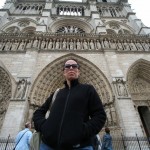
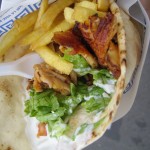
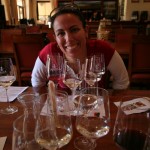
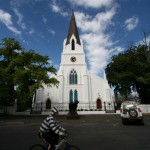
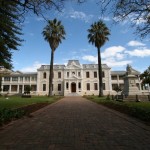
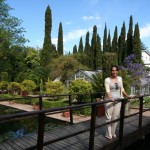
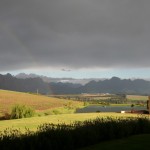
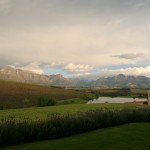
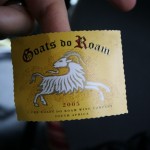
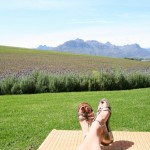
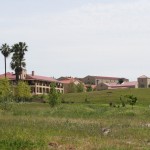
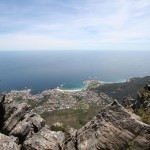
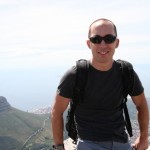
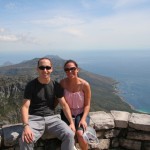
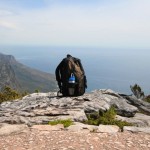
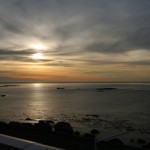
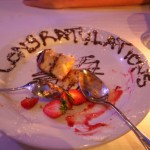
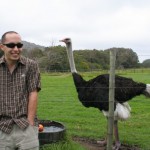
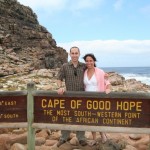
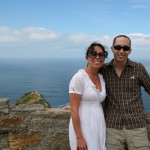
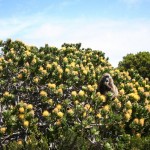
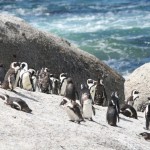
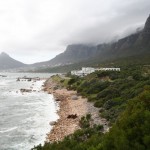
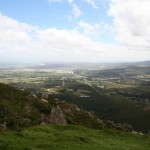
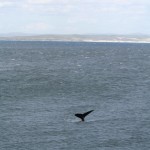
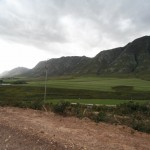
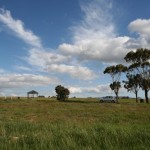
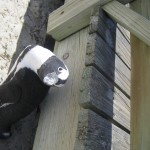
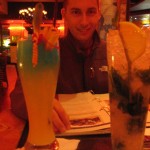
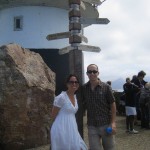



October 23rd, 2009 at 12:20 pm
Goats Do Roam! That’s the winery Michelle and I were telling you about (Fairview). Did you get to go? Can’t wait to hear all the stories when you get back. We’ll have to drive down and visit!
January 9th, 2010 at 9:41 am
Hello, I am so excited that you explored my city (Cape Town) and country (to a certain extent:-)! I am a person of color (so-called Colored as some of us in SA prefer to be referred to as) residing in the US at the moment. Yes, the effects of apartheid is still very much visible when it comes to economical inequality as well as “mental” inequality. You are right, we still have some way to go for a very young (16 years) democracy. But, we have done quite well I think considering where we came from. It is a pity that you did not go to Johannesburg, the country as well as continent’s economic Mecca. There you will see a different reality…a significant (drastically visibly so) amount black people driving the Mercs and BMW’s and in high profile CEO positions as well as a big wave of young, black South Africans making it happen for themselves. I lived there for about 6 years and not a lot of Capetonians dare to even visit, let alone live. Unfortunately foreigners prefer not to visit due to the unfortunate bad rep the city has due to its highly publicized crime incidents. However, JHB is no different to big cities where there is money such as NYC, London or Tokyo. You were a tourist seeking a vacation experience, not social study, so you went to the most popular tourist areas and you had to, because that is how you ease into SA so that you can hopefully go back and dig a bit deeper. Like here in the US people are spread out all over SA based on various cultures and colors as well as attitudes and based on what their comfort zones are. The majority of South Africans are Black (79% out of a total population of 49 mil people; white are at about 9.6%) who had a huge disadvantage due to our past, with very poor education opportunities and exposure to the rest of the country let alone the rest of the world (which is what places like Cape Town feels like) so that is why you will see mostly black people working low income jobs and living in informal housing in areas where you see mostly white people. In addition, home for most black people are not the cities. They come from the “homelands” which are rural areas in the Eastern Cape or Kwazulu Natal and only move to the cities for work which is why the township is so “informal” because for most people this is a second home. I am not saying it is right and not defending rich white people in SA and saying it is acceptable, but we have some way to go to see a substantial amount of black people in places like Cape Town in key professional positions or living in suburbs such as Camps Bay and the Winelands because these cities have been traditionally a haven for white people with money (black people need to go via Johannesburg first). I am really proud of how much we have covered in such a short time. As people of color (mainly black and colored – we also have Indian/Asian in this category) have access to improved education, more exposure to the rest of the world and learn from our Westernized friends, I think the economic outlook for many South Africans of color will improve. However, sometimes the love for money alters ones values for the worse and you can be worse off than what you were before coming from very little. However, South Africans have an amazing sense of community and firm moral standings due to strong family ties. Going back to the socio/economic progression, affirmative action is strongly practiced, however in certain industries it needs to improve, but this is due to people of color not necessarily being interested in those industries. Our country’s progress, especially socially is so inspiring to us all as well as to visitors. Thanks to a man who was the right person for the right time…hope you have seen Invinctus. You should also see movies such as White Wedding (SA comedy) and Red Dust (Truth and Reconciliation based story) to get an idea of where we were and where we are now as a society. For a look into young urban adults of color, watch movies such as Bunny Chow, that is if you can find any of these films here. I have been accused of being very positive about our country and have friends who will only focus on the negative and that is all they see, but we are all allowed our own way of looking at things with the same facts at hand, however our experiences have been different, but we still respect each other’s points of views.
January 11th, 2010 at 11:48 am
@Melony – thanks for taking the time to leave such a well-considered comment; I’m glad you found your way here. I agree with you on most of your points. My wife and I have traveled extensively and in general we try to get off the beaten path and away from the crowds whenever possible. This was a special trip for us as it was our honeymoon and we had limited time away from work. We didn’t avoid JNB per se, we just had only so much time on this particular trip.
I don’t think anyone should believe the bad rap that big cities get – they can all be dangerous if you find yourself in the wrong place at the wrong time. And, of course, even in the right place at the right time things can go wrong. That’s life and all you can do is keep a positive attitude.
We heard South African expats several times during our trip tell other South Africans how impressed they were with the changes and improvements in the country since the end of apartheid. I think for having only 16 years under their belts, the country is doing quite well. It does boil down to education though, and I hope that the country will invest the necessary amounts to get everyone proper schooling. It’s the only way to truly move everyone to a more level playing field so fingers are crossed (that is, if the new energy prices don’t bankrupt everyone!)
I have a movie about Joburg on my laptop that I downloaded from somewhere; I never had the chance to watch it while I was there but I will go back to watch it now. I’m not sure if it’s Bunny Chow or another but it is a documentary.
Thanks again for the comment and good luck during your time here and if in the future you return back to SA!